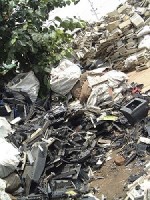 An article discusses the growing threat of e-waste.
An article discusses the growing threat of e-waste.
So much of technology is made to be thrown away, reported The Atlantic, which is not good for either “consumers or the environment”. Companies like Apple are increasingly bringing out new phones on a yearly basis, which means a perfectly usable phone is discarded for the new upgrade, and the same goes for other hardware – even small malfunctions mean that instead of repairing the item is thrown away.
The report used the example of printers, and said that “buying a new printer is cheaper than buying a set of new ink cartridges”. The effects on the environment are two-fold; mining is increased to provide raw materials required for production, and the unwanted devices are thrown away. To reduce e-waste the report suggested reuse, repair or resale, but questions whether this will ever be a reality.
Environmental Data Services (ENDS) reported that sales to replace defective items have increased from 3.5 percent in 2004 to 8.3 percent in 2012, and that the “large household appliances” that need replacing within five years increased from seven percent in 2004 to 13 percent in 2013. There has always been electronic waste, but the report noted that the “quantity and speed of discard has increased rapidly in recent years”.
Interestingly, a Gallup poll in 2014 reported that 89 percent of young people owned smartphones, as opposed to 41 percent of the older population who owned VCRs at the same age. Electronic devices have become cheaper to buy due to manufacturing, and repair can be at a higher cost as well as inconvenient, making new purchases “more economical”. Companies have started to end support and apps on older models, and are promoting discarding the old and purchasing the new.
Printer manufacturers on the other hand have “realised that they can make more money selling ink and toner than the printer hardware itself”, and according to a Financial Times report, a gallon of ink for the typical printer costs the consumer $8,000 (€7,152), and as printers are cheap to buy once the ink is used, the consumer is “tempted to buy” a new printer.
E-waste produces toxins that enter the soil and water supplies, and if not disposed of properly, toxins from electronic waste can enter the soil and water supply, and this is an ecological issue raising alarm about pollution of air, water, soil, “information security and even human exploitation”. In the US, e-waste is regulated and recycled, but much still finds its way to landfill, and the report said that of the $206 billion (€184 billion) spent on electronics, “only 29 percent was recycled”.
Consumers and manufacturers must take some responsibility, although not all, the articles states, and repairing rather than discarding as well as reselling or recycling can help to make a difference. Governments, it adds, need to regulate e-waste “and the companies [that make the electronics]”, and create more e-waste processing sites. It concluded that everyone has a part to play in the reduction of e-waste and the protection of the environment, starting by thinking before discarding.
